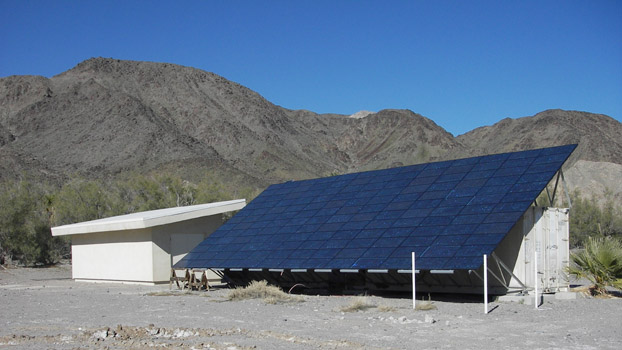 Caption: Workmen will erect solar panel arrays atop the roofs of three campus buildings and update the system at the CSU Desert Studies Center in the Mojave Desert, shown with the solar panels installed in 1992. Photo: Robert Fulton
Caption: Workmen will erect solar panel arrays atop the roofs of three campus buildings and update the system at the CSU Desert Studies Center in the Mojave Desert, shown with the solar panels installed in 1992. Photo: Robert Fulton
Sun Power
CSUF to Begin Photovoltaic Project
Cal State Fullerton officials soon will be wishing for long, sunny days — because those rays of sunshine will become power for the 236-acre campus.
Later this spring, campus and community members will begin noticing construction workers on the rooftops of the Eastside Parking Structure, Clayes Performing Arts Center and Kinesiology and Health Science Building. The workers will be placing solar panels that will eventually supply 7-8 percent of the electrical power that the university uses daily — about one megawatt of power.
“When we need the power the most, this system will be able to supply it,” said Willem van der Pol, director of physical plant. “We hope to have this running in time for the fall semester, when the weather is pretty hot and there are lots of students, faculty and staff moving around in our buildings — using lights, air conditioning, computers and other equipment. This will be the time when the solar panels will be their most efficient.”
That, added to the savings generated through the campus’s other energy-generating efforts — such as the new trigeneration plant, installed and made operational last year — will bring the university’s self-generating electrical generation capacity to nearly 6 megawatts of power.
“Cal State Fullerton has been a regional leader in incorporating sustainability into campus operations. This solar power project once again demonstrates CSUF’s leadership, not only in providing alternative power sources for the university operations but in funding them in ways that are a benefit to the taxpayers, a crucial issue given today’s budget concerns,” said John Bock, director of the university’s Center for Sustainability and coordinator of the university’s Environmental Studies Program. “CSUF also is making sustainability a priority in research, teaching and community engagement, and supports faculty and student activities with internal and external funding opportunities.”
Van der Pol agreed. “Cal State Fullerton is a leader and has a long history of energy conservation and other sustainability efforts. This project is just the latest in our ongoing efforts.”
The project, unlike earlier photovoltaic proposals, will be self-funded by the university. In addition to lowering the carbon footprint of the campus, it will bring long-term financial benefits, said van der Pol, who noted that the $6 million system will be paid off in approximately eight years.
The project also should garner more than $1 million in financial incentives from Southern California Edison, added van der Pol.
March 29, 2011
